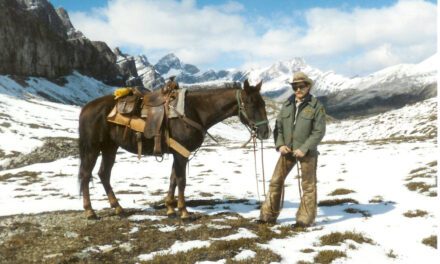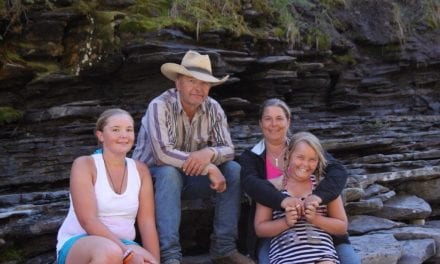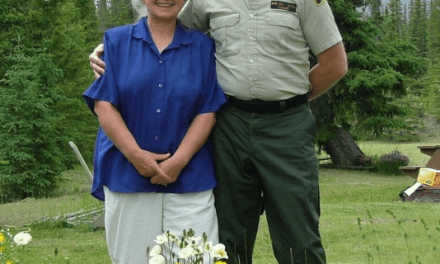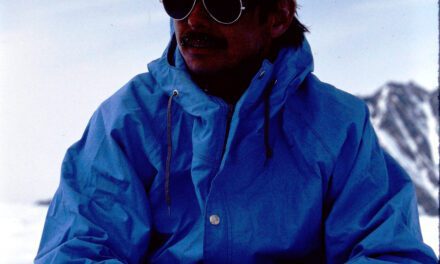So, then our second son was born at Nahanni …. Well, that was a bit of a long story and an interesting one but I’m not sure you want to hear about it.
SH: Sure, go for it.
Hal: Our first son, Matt, was born at Fort Simpson. Normally because you’re in an isolated post, they want the woman to go into Fort Simpson two to three weeks before due date. That way there’s no big panic, having the kid born at an isolated post with no medical people. Anyways, the first kid when she started to go into labor to when the kid was born was real fast …. like about an hour or something.
So, with the second kid – Chad, Janice is ready to go in the next day, it’s like three weeks before her due date, and she wakes me up in the middle of the night, and says “Things are happening here”. Oh no. Just cross your legs and don’t think about it, but that isn’t the way it works. It’s the middle of the night and it’s in March, and it was still pretty darn cold outside, and I really don’t want to be delivering this kid myself. So, I went over to the office and got on the radio phone and called up the nurse at Fort Simpson, so she said “We’ll see what we can rig up and try to get out there, but it’s the middle of the night.”
So, they managed to get special IFR for the plane. Our strip is real short. It was about 1700 feet long and you didn’t want to be too soon on the strip, because it was a mud bank on the river, and you didn’t want to be running too far on the strip because it ended at a big mud bank on the river on this kind of rounded peninsula. So the pilots normally didn’t like trying to land on that strip when it was dicey weather. Anyways, the pilot at the time, I can’t remember his name, but we called him Captain Crude because he was a funny guy and had a lot of off colour jokes, but he said Yup… And we’re at the base of a 4500-foot mountain. But he said “Yup, I can plunk it down but you guys gotta light up the strip for me.” So Chuck Blythe and I went out with skidoos, and we had a couple of five gallon pails full of toilet paper rolls that we’d soaked in diesel. So we hear the plane circling overhead. Chucks on one side of the strip and I’m on the other side and we’re skidooing down the strip and lighting these toilet paper rolls soaked in diesel, just dropping these flaming bombs all the way down the sides of the strip. It was fun and freaking beautiful by the time we’d finished. It was like a Hawaiian luau.
The pilot was laughing away and thought it was the best, well-lit runway he’d seen. He plunks down the twin otter and the nurse gets out. I said, “Where’s the regular nurse?” She said, “She had to go to Edmonton. I’m the new nurse, I just arrived in Fort Simpson four days ago.” I noticed that her arm is in a sling and she’s in a cast. So I asked “What happened there and how are you going to deliver the baby?” She said, “When I was moving my furniture I broke my arm, but I brought along a nurse trainee that I can direct on how to deliver the baby.” Off we went in the Twin Otter. With no one in Fort Simpson to deliver the baby, we were met at the Fort Simpson airport by a citation jet that whisked us off to Yellowknife. We got to Yellowknife in record time, and they got her up to the hospital. Chad was born five or ten minutes later. How’s that for a story.
SH: That’s an amazing story. I love that. (Tape 25:51)
Hal: After Chad was born, we went back to the Butte but we were only there for about two weeks if that. We’d already had this transfer rigged up to go to Cape Breton Highlands National Park (CBH), another spectacular, beautiful park but such a completely different setting and at the other end of Canada. It was a mistake moving that early after having a kid because it was hard on Janice and the baby. One kid was almost two years old, the other was brand new, he was just fresh out of the oven.
SH: Yes, that’s a long way and very different park and people.
Hal: Yes, wonderful people, we had a great crew to work with there. We were posted at a station that was about three kilometers outside the town of Pleasant Bay, at Grand Anse Warden Station, we were there about three plus years. It was a great place.
SH: Who was there when you were there Hal?
Hal: When I was there the Chief Park Warden was Al Gibbs. He was over on the Ingonnish side, and the Area Manager on the Cheticamp side, my station was on the Cheticamp side, was Yves Bosse and then there was Bob Thexton, Mac Savoie, Gerald Bourgeois, Derek Quon, Jennifer Hoffman, Randy Thompson, Scott McBurney and a few more.
So CBH, well Yves was only there about a year or so, and then he transferred up to Pangnirtung, and then I was the acting area manager on the Cheticamp side for over a year anyways. When you’re living on a station, you’re doing everything from selling fishing licenses, poaching patrols, vehicle accidents as well as helping on the Atlantic salmon conservation program. We had a counting weir on the Cheticamp River. Active poaching patrols on the Cheticamp River for fishermen who weren’t playing by the rules. There was quite a bit of electrofishing to assess reproduction in certain streams.
Poaching was actually kind of a big deal out there too. During the winter, well fall and winter, there was quite a bit of poaching for deer and moose. On the Ingonnish side, and Cheticamp side too, there were some larger campgrounds, but on the Ingonnish side, during the two big long weekends, the May long weekend and the August long weekend, there was two campgrounds that would get kind of raucous and they would call in wardens from throughout the park and we’d have to do our stint as a campground cowboy for a couple of nights.
SH: We were in that park years ago and it was spectacularly beautiful.
Hal: Yes, spectacularly beautiful and the backcountry was accessible and usable during the winter, you’d get big snowfalls there too. We skied to where a backcountry cabin was, we knew where it was but there was no evidence of the cabin, until we dug down and found the stove pipe. But during the summer if you had to go into the backcountry, it was tough. It was mostly black mud, and bogs.
SH: And a few bugs.
Hal: Yup, although nothing rivaled the bugs in Nahanni. That was full on. We lived in trailers there and you couldn’t keep the mosquitos out, there was no way. We would set up those bug nets to sleep under like what they use in Africa, and in the morning, there’d be 50 or 60 mosquitos sitting on the bug net looking in at you. Cape Breton certainly had its good share of mosquitos and black flies, but nothing compared to Nahanni for mosquitos. You got to wonder, because to be able to survive there you’d take three or four Deep Woods Off baths a day, you’d just spray yourself down from head to toe, otherwise you’d go nuts. The morning ritual in the trailer was to spray it down with Raid and then go out for a walk wearing your bug jacket. So you got to wonder, holy mackerel, all that stuff you were breathing and putting on you, that couldn’t be that good.
SH: What year were you in Cape Breton Highlands?
Hal: I went there in ‘88 and left there in November of 1990, so about three years.
SH: It’s nice to get the chronology. So, in November 90 where did you head?
Hal: To Yoho. Some of the people working there at the time, Paul Kutzer was the Chief, Gord Rutherford was the Area Manager or Assistant c\Chief, Terry Willis, Terry Winkler, Ed Robert, Cal Sime, Harry Abbott, Randall Robertson, Reg Hawryluk, Jamie Fennel, those were some of the people working around that time.
SH: Okay, and you were a full-time warden in Yoho, like a GT-03.
Hal: Ya, I’m not sure we’d made that jump to GT-03’s yet. I’d moved to Nahanni as a full-time warden and it was a GT-02 at the time, and transferred to CBH as a full-time warden, and transferred to Yoho as a full-time warden but I think we were GT-02’s at the time, we hadn’t been upgraded to 3’s. That’s how I recall it, but my memory is not the best on dates.
SH: So, did you live in Field?
Hal: Yes, we moved into Field. It was a really nice, interesting community at the time. A good young vibe to it, there was probably 30 kids at the school which suited us well, because when we moved there, we already had two kids and we had one on the way. Lots of interesting fun people in the town. The town had a nice vibe to it.
SH: Your boys were school age at that time?
Hal: No, they weren’t at the point. The oldest, Matt was probably four and a bit, and the middle kid was two and a bit and our daughter hadn’t arrived yet. I should start using their names.
SH: The boy who was born in Yellowknife, what was his name?
Hal: My oldest son, Matt was born at Fort Simpson and the middle son, Chad he was the baby that arrived almost in mid-air but born in Yellowknife, and then Shyler, our youngest, our daughter, was born in Banff in ‘91.
SH: Hey my kid was born in Banff in ’91 too so there you go.
Hal: They gave mothers to be, pretty good treatment in Banff.
SH: They did indeed, they don’t anymore, but yes it was great! (End part one – Tape 36:20)
So what were your duties in Yoho then?
Hal: When I arrived there what was on my plate was law enforcement and problem wildlife was how we termed it at that time. So those were my two main responsibilities but in a small park you pitch in on a lot of things and of course that’s just great, because you keep the interest up and you get to train and be multi-disciplinary.
SH: That’s a great thing about that park; there’s a lot to do there for sure. How long were you in Yoho for Hal?
Hal: I was in Yoho until we became LLYK (Lake Louise, Yoho, Kootenay) in 1997, so 1990 to 97 Yoho and then LLYK until I retired in 2013.
SH: When you were in LLYK did you live in Golden or here in Invermere?
Hal: We continued to live in Field. We lived in Field for 23 years.
SH: Seriously? Wow. You must have liked the dark days.
Hal: Well, you know it wasn’t all that different from being up north really. It was such a nice little treasure because you didn’t have the intense use of the townsites like Lake Louise and Banff. It was a nice little spot and a great place to raise our kids.
SH: So were your kids were on the bus to Golden until you left?
Hal: Yes, all of them finished high school in Golden. Field at the time still had a school that went up to Grade 3 but they all bused into Golden and finished high school in Golden.
SH: So you retired in Field and then moved out to Hornby? Is that how that worked?
Hal: That’s how that worked.
SH: I didn’t realize that. Let’s go on to what did you like about being a warden and what didn’t you like? (Tape 2:34)
Hal: We didn’t cover what I was doing in LLYK.
SH: Ya, let’s go back there. Sorry Hal, let’s go back to LLYK. What were you up to?
Hal: I was the wildlife human conflict specialist for LLYK. It was kind of a fancy title, but it was trying to get away from calling it problem wildlife, because it wasn’t really the wildlife that were being the problem. In essence my job was to keep wildlife and people from hurting each other. I loved it; that was a great job. The wildlife in many respects was mostly just trying to make a living in the best habitat available which of course is where we’ve got most of our human use. I had two permanent people working for me and probably about six or seven people in the summer, so I had quite a bit of help in the summer and some help in the winter, but it was a great job. Everybody was busy. We had around 700 Wildlife Conflict occurrences per year, about 90% of those were bears.
SH: You had some interesting bears there. Do you want to tell some of those stories right now, do you want to tell some bear tales of your job there?
Hal: Well, like I mentioned wildlife is usually just trying to make a living and it was our job not only to ensure that people could enjoy the park, but to try to sustain healthy populations of many animals, and high-profile animals like grizzly bears. We did a lot of things that I was fairly proud of in LLYK. We pushed the envelope on a few different things. During my time there we reduced grizzly bear morts (mortalities), even though the railway and the highway were still claiming a few … well some grizzly bears, but still claiming quite a few animals.
Aversive conditioning had already been started in Canada’s mountain parks by I think Ronnie Leblanc and Terry Skjonsberg. We built on that and tried to bring a bit more rigor and stringent consistent guidelines on how we were trying to apply it, and we had some successes. But also, we tried to bring some consistency with some guidelines and kind of codes of conduct around hazing and use of deterrents. Hazing, that one was a bit difficult because a lot of wardens wanted to quickly resolve bear jams and some other occurrences by use of rubber bullets and screamers and bangers but used in a variety of situations and even over applied in many situations. So, we tried to bring some guidelines to that as well. What we were looking for of course was consistency and making an informed decision on when to apply those tools. We put an E fence (electric fence) around the Lake Louise campground and Skiing Lake Louise followed suit. E fences definitely helped reduce risk and allowed people to still utilize those areas inside the fence as well as grizzly bears and wildlife figured out how to move around those areas with reduced chances of bumping into people. Those were pretty good success stories and difficult to achieve. Getting a fence around Lake Louise campground took several years of convincing and behind the scenes work as far as evaluating risk and how are we going to be able to deal with the main gate. How do people drive in and out and also the river was right there so how do we deal with that as well with an electric fence. There was a lot of concern around kids and people let’s say, with a heart condition. Are we going to be electrocuting them? So, it took quite a while to cover all the bases and get it implanted and get it installed and it turned out to be a real positive thing.
‘Group of four’ in Moraine Lake area. Such a beautiful area and everybody wants to see it. So overused by people and bears are still trying to make a living in that landscape. We had some tight scrapes. I had a tight scrape up there too with an adult grizzly bear. But group of four, it started off as a group of six and that was difficult to achieve for the public. The group of four worked far better and still managed to achieve what we wanted which was public safety but also, when you have people traveling in groups of four, you’ve clumped your disturbances on the landscape, like going up to Paradise (Valley) as well as going up to Sentinel Pass and Larch Valley and such and it was easier for bears to be able to avoid people if they were clumped. On some of the high use days up there before group of four, it was just a constant, never-ending stream of people on the trails.
We had Carey Hunt up for about a month on contract with Korelian bear dogs. We had a good chance to see what Korelian bear dogs could help us out with and assess the capabilities. So, we took a good look at that program. They are a useful tool, but we didn’t end up pursuing that. As well we ran a program where we collected all our road kills over the winter and redistributed carcasses up on the landscape to help draw bears away from some of the townsites in the spring, when they first come out of their den, they usually check out avalanche slopes and then go down to other areas that have melted out and provide some food opportunities. Unfortunately, that is Lake Louise, Field and a few other low-lying areas. So with the carcasses redistributed we were buying a little bit more time and letting some of the other areas melt out a bit more. All these animals were killed on the road; elk, deer, and the odd mountain goat and a few other small animals. We’d have quite a pile, and they were all killed in the national park, and why not let that energy go back into the park itself. So those were some of the things that we worked on and implemented, and we had some pride in.




This was a great read, glad I had the pleasure of working with Hal in Cape Breton Highlands National Park . Janice used to make us a wicked cup of “stake out “ coffee to take out on night time poaching patrols.